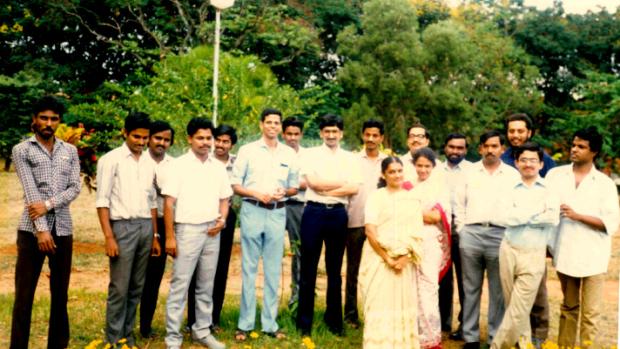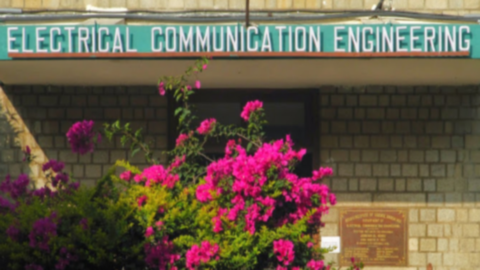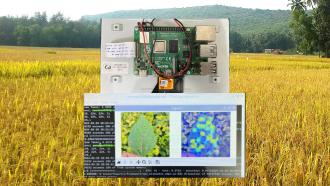
Photo: ERNET Team, ECE, IISc
India today has the second largest number of Internet users in the world with about 350 million people accessing the Internet, either through their smartphones or computer. With the advent of fibre optics and 4G technologies, the race for providing Internet services is hotter than ever. Today, there are close to 20 Internet Service Providers (ISPs), including Airtel, BSNL, MTNL and latest to join the bandwagon – Reliance’s Jio.
If you time-travelled thirty years into the past, when India had a few premier educational institutions and the Internet was in its infancy, have you wondered how these institutes were connected? The Education and Research Network, or better known as the ‘ERNET Project’, served the purpose of connecting the different academic institutions across the country and introduce research in networking in the country. ERNET was initiated in 1986 by the then Department of Electronics (DoE) (today’s Department of Electronics and Information Technology -- DeitY) and the United Nations Development Program (UNDP) with funding support from the Govt. of India.
In its first avatar, ERNET involved eight premier institutions as participants including the Indian Institute of Science (IISc), National Centre for Software Technology, five Indian Institute of Technology (IITs) and the DoE. Its first task was to set up a Local Area Network (LAN), which meant networking the computers within the campus of an institution and then connecting the LANs of the various institutions using a Wide Area Network (WAN). Thus, an inter-campus networking service was created, providing an opportunity for many to work with computers.
“In June 1986, when the ERNET project proposal was being finalized, I saw a computer for the first time in my life and started to learn the very first day”, recollects Dr. Chandrika Shridhar, who worked on the ERNET project from 1986 to 2016. She was one among the many who fostered their networking skills and involved in research in computer networks.
As the next logical step, IISc aimed to provide email access to its various departments using the Unix to Unix Copy Protocol (UUCP), a predecessor to the currently used TCP/IP. UUCP served as the backbone to sending and receiving emails and could also dial in to a similar system in USA -- the UUNET -- and exchange emails with the universities there.
Setting up an email server was a breakthrough since it was a first-of-its-kind in the country, and laying the groundwork was an arduous task, involving laying more than a kilometre of Ethernet cables, some of them running underground, that connected the systems in different departments.
ERNET evolved over time under the guidance of Prof. Anurag Kumar, the current Director of IISc, who became the ERNET project coordinator in 1988. Prof. Kumar’s expertise in computer networking came during his days at Bell Labs Inc., which was at the forefront of networking research back then. After returning to India, he took up the enormous task of setting up the campus-wide network. “Although the Internet started in the 70’s, it took some time to come to India. There was also a need for inter-campus networking and networking among the universities to coordinate their research efforts. ERNET was a nationwide package that connected different universities in the country”, remarks Prof. Kumar.
By 1992, ERNET had grown big with several universities in Bangalore dialling in to use the networking service and had become the country’s first internet service provider. With VSNL (now TATA Telecom), Internet access to households was started in 1995, 3 years after academic institutions across the country had full Internet access through ERNET. In 1997, the final project review was done and the expert panel concluded that the project was a success, with UNDP praising the project as one of the most successful initiatives it had funded. Following this, in 1998, the ERNET project became ERNET India, an autonomous society under the DoE.
Although the project was initiated to set up an inter-campus network, it had evolved into the country’s first attempt at exploring the Internet. But the lasting legacy of the project is in training a generation of individuals skilled in data networking. As Prof. Gopi Garge, who worked on ERNET between 1988 and 2016, puts it “ERNET was an experience of my lifetime. Networking learnt right through as it evolved, and being there and doing that, is priceless.”

After the formation of ERNET India, the focus has now shifted from research to providing Internet services. Currently, ERNET India serves more than 1300 Institutions across the country and apart from providing Internet services, it also provides consultancy, project management and value added services like web hosting and e-mail services.
So, with Internet now being a commonplace, what does the future hold for the brightest minds in our universities? The time is now ripe to ride on the wave of Internet of Things (IoT), say the experts. “The current government is pushing for IoT through start-ups. This is good but there is no overall coordination among the different researchers and institutes. We need to have a consortium of the start-ups and researchers to advance research in the field. IoT is similar to ERNET in the 80’s, still in its infancy. It would be worthwhile to have an ERNET like effort for IoT,” signs off Prof. Anurag Kumar looking forward to the next big thing.






